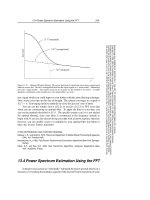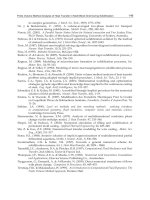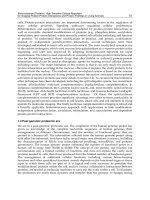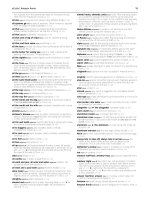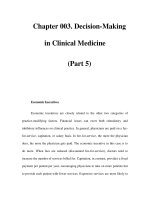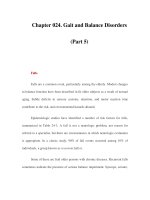Chapter 025. Numbness, Tingling, and Sensory Loss (Part 5) ppt
Bạn đang xem bản rút gọn của tài liệu. Xem và tải ngay bản đầy đủ của tài liệu tại đây (13.41 KB, 5 trang )
Chapter 025. Numbness, Tingling,
and Sensory Loss
(Part 5)
Touch localization is performed by light pressure for an instant with the
examiner's fingertip or a wisp of cottonwool; the patient, whose eyes are closed, is
required to identify the site of touch with the fingertip. Bilateral simultaneous
stimulation at analogous sites (e.g., the dorsum of both hands) can be carried out
to determine whether the perception of touch is extinguished consistently on one
side or the other. The phenomenon is referred to as extinction. Graphesthesia
means the capacity to recognize with eyes closed letters or numbers drawn by the
examiner's fingertip on the palm of the hand. Once again, interside comparison is
of prime importance. Inability to recognize numbers or letters is termed
agraphesthesia.
Stereognosis refers to the ability to identify common objects by palpation,
recognizing their shape, texture, and size. Common standard objects, such as a
key, paper clip, or coins, are best used. Patients with normal stereognosis should
be able to distinguish a dime from a penny and a nickel from a quarter without
looking.
Patients should only be allowed to feel the object with one hand at a time. If
they are unable to identify it in one hand, it should be placed in the other for
comparison. Individuals unable to identify common objects and coins in one hand
and who can do so in the other are said to have astereognosis of the abnormal
hand.
Localization of Sensory Abnormalities
Sensory symptoms and signs can result from lesions at almost any level of
the nervous system from parietal cortex to the peripheral sensory receptor. Noting
the distribution and nature of sensory symptoms and signs is the most important
way to localize their source. Their extent, configuration, symmetry, quality, and
severity are the key observations.
Dysesthesias without sensory findings by examination may be difficult to
interpret. To illustrate, tingling dysesthesias in an acral distribution (hands and
feet) can be systemic in origin, e.g., secondary to hyperventilation, or induced by a
medication such as acetazolamide. Distal dysesthesias can also be an early event
in an evolving polyneuropathy or may herald a myelopathy, such as from vitamin
B
12
deficiency. Sometimes distal dysesthesias have no definable basis. In contrast,
dysesthesias that correspond to a particular peripheral nerve territory denote a
lesion of that nerve trunk. For instance, dysesthesias restricted to the fifth digit and
the adjacent one-half of the fourth finger on one hand reliably point to disorder of
the ulnar nerve, most commonly at the elbow.
Nerve and Root
In focal nerve trunk lesions severe enough to cause a deficit, sensory
abnormalities are readily mapped and generally have discrete boundaries (Figs.
25-2 and 25-3). Root ("radicular") lesions are frequently accompanied by deep,
aching pain along the course of the related nerve trunk. With compression of a
fifth lumbar (L5) or first sacral (S1) root, as from a ruptured intervertebral disc,
sciatica (radicular pain relating to the sciatic nerve trunk) is a frequent
manifestation (Chap. 16). With a lesion affecting a single root, sensory deficits
may be minimal or absent because adjacent root territories overlap extensively.
With polyneuropathies, sensory deficits are generally graded, distal, and
symmetric in distribution (Chap. 379). Dysesthesias, followed by numbness, begin
in the toes and ascend symmetrically. When dysesthesias reach the knees, they
have usually also appeared in the fingertips. The process appears to be nerve
length–dependent, and the deficit is often described as "stocking-glove" in type.
Involvement of both hands and feet also occurs with lesions of the upper cervical
cord or the brainstem, but an upper level of the sensory disturbance may then be
found on the trunk and other evidence of a central lesion may be present, such as
sphincter involvement or signs of an upper motor neuron lesion (Chap. 23).
Although most polyneuropathies are pansensory and affect all modalities of
sensation, selective sensory dysfunction according to nerve fiber size may occur.
Small-fiber polyneuropathies are characterized by burning, painful dysesthesias
with reduced pinprick and thermal sensation but sparing of proprioception, motor
function, and deep tendon reflexes.
Touch is involved variably; when spared, the sensory pattern is referred to
as exhibiting sensory dissociation. Sensory dissociation may occur with spinal
cord lesions as well as small-fiber neuropathies. Large-fiber polyneuropathies are
characterized by vibration and position sense deficits, imbalance, absent tendon
reflexes, and variable motor dysfunction but preservation of most cutaneous
sensation. Dysesthesias, if present at all, tend to be tingling or bandlike in quality.
